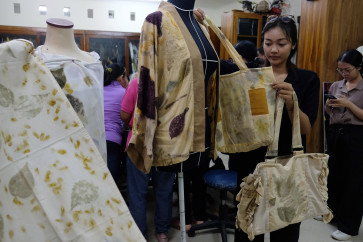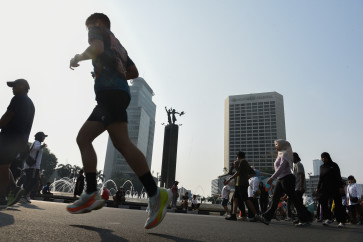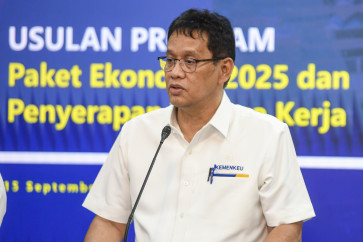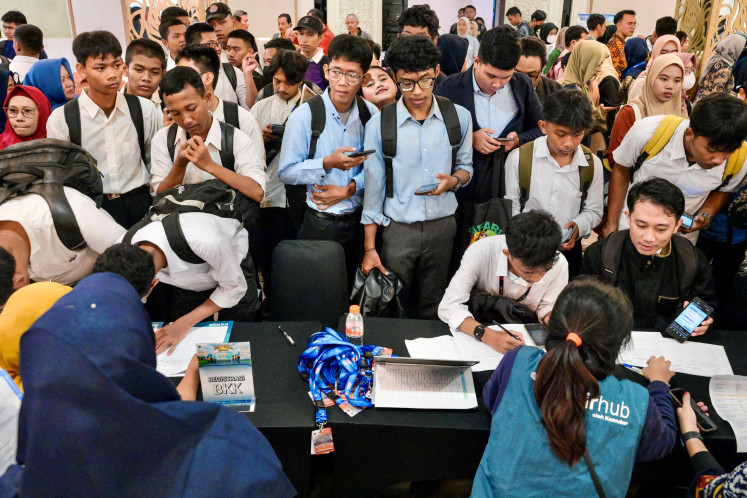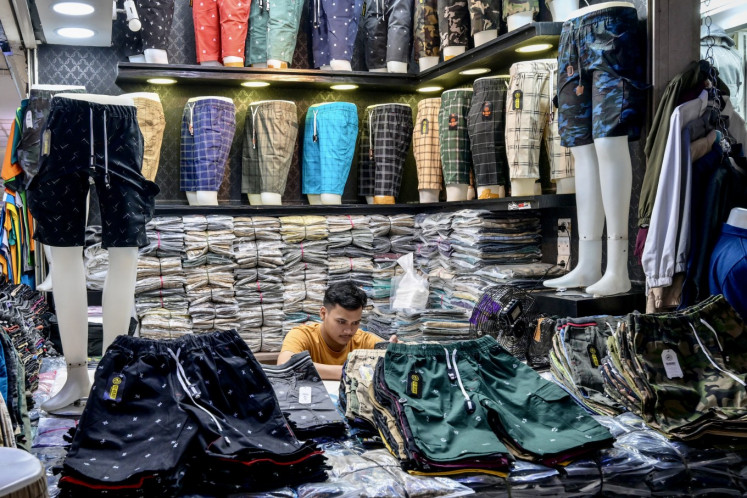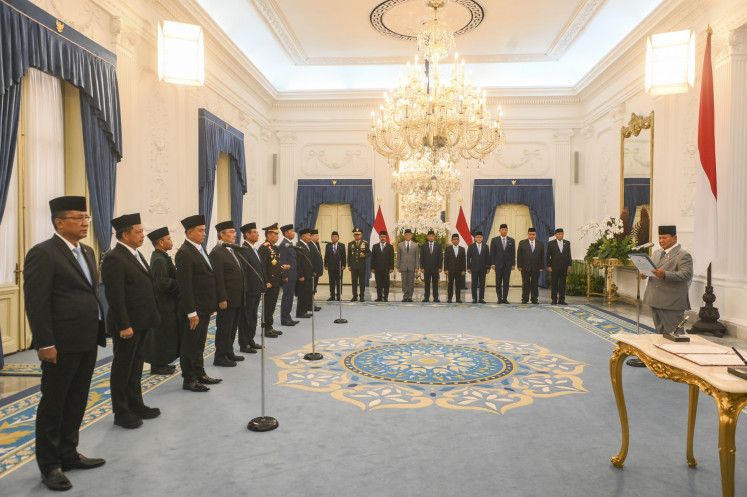Popular Reads
Top Results
Can't find what you're looking for?
View all search resultsPopular Reads
Top Results
Can't find what you're looking for?
View all search resultsHolding on for a superhero
On May 5, 2008, a film poster appeared on kafegaul
Change text size
Gift Premium Articles
to Anyone
O
n May 5, 2008, a film poster appeared on kafegaul.com’s message boards. A smiling man seen from the back, his face obscured by a winged mask. Beyond him, the Jakarta skyline. Below, the words Gundala: Putra Petir (Gundala: Son of Lightning), and a release date: June 2009.
Artist impression of scene from Gundala movie. Courtesy of Iskandar Salim
The poster of the popular Indonesian superhero spread like wildfire across the Internet, supported by a website, a Facebook fan page — and that pinnacle of Web 2.0 veracity: a Wikipedia entry stating the film was a “collaboration of the country’s young talents, dedicated to [capturing and presenting] a breathtaking superhero adventure”, with special effects by Clockwork Factory, a local production house.
While the Wikipedia page remains, the truth has since been revealed and the mastermind unmasked. The poster, the website and accompanying social media were the brainchild of Iskandar Salim, a wedding videographer who also works as a digital artist and graphic designer.
Iskandar, a lifelong fan of comics and superheroes, says he executed the hoax for fun and to gauge reactions, with no malice or profit-seeking intended.
“Also, I’m dying to see movies featuring local heroes. Imagine this, one day you walk into a cinema lobby and you see this big movie poster of the hero from the comic book that you read as a child.
“Our neighbouring countries have already made their own superhero movies — with mediocre results, in my opinion. Why can’t we?”
Indeed, that’s exactly what the hoax was intended to be: starting a debate on whether there could be an Indonesian superhero film with high production values. The first — and only — Gundala film was a low-budget and lower-tech affair in 1983 starring Teddy Purba as Gundala and W. D. Mochtar as his arch-nemesis Ghazul.
“I tracked down blogs and discussion forums to read people’s reactions. They were mixed, but mostly positive. Some even said no matter how bad the movie turns out, they would still go and see it,” Iskandar says.
Two years on from the hoax, it seems Iskandar and other anxious Gundala fans may finally get their wish, with reports of a new Gundala film, or at least a film that channels Gundala’s spirit.
Movie director Andi Bachtiar Yusuf, known for his soccer films and documentaries, says he is adapting a screenplay for Dr. Jaka dan Ki Wilawuk, with the Mo Brothers, Kimo Stamboel and Timo Tjahjanto directors of movie Rumah Dara. The original tale incorporates elements of Robert Louis Stevenson’s horror Dr. Jekyll and Mr. Hyde.
“I proposed it be dark like The Dark Knight, but we thought about it again, and decided it needed humor and action, and should be aimed at a teenage audience. Dr. Jaka has tons of comedy in it,” Andi says.
Dr. Jaka is one of titles in Gundala comics.
However, Gundala creator Harya Suraminata aka Hasmi says the film is not definite as a deal has not yet been inked with PT Bumi Langit, which owns Gundala’s copyright, although he is in favour of a new production.
Indonesian comics first appeared in the 1930s, with comic strips circulated among urban and upper-class Indonesians. The characters drew on local lore and American superheroes, many of which also originated in the 1930s. Gundala, who debuted in 1969, was inspired by an American superhero, especially DC Comics’ the Flash.
“When I was eight I was very keen on reading comics especially superhero ones such as Superman, Batman, Phantom and the like. So when I felt I could make my own comic strips, I started to create my own character, Gundala,” Hasmi says.
“I was inspired by the Flash, who can run as fast as light speed, but to my mind is less human. So I wrote Gundala as a character able to run 400 kilometres per hour. And he spouts thunder from his palms.”
Indonesian comics enjoyed a heyday in the 1970s and 1980s — when Gundala was very popular — but have never achieved popularity outside of Indonesia.
Perhaps a new Gundala film could change that, or at least bring Indonesian comics to the national mainstream, in the way the current flush of American superhero films have contributed to the dramatic rise of “graphic novels”, the highbrow labelling for comic books, which also serve as another indicator of the increased esteem for what was once the preserve of fanboys.
All signs point to this being the right time for a revival of Indonesian superheroes, especially in cinematic form. The last time Indonesian superhero films were in vogue was in the 1980s, following the success of the 1978 film Superman starring Christopher Reeves. Gundala and the remake of the Six Million Dollars Man by comedic trio Dono Kasino Indro titled Manusia 6.000.000 Dollar were among superhero flicks from the period.
In 2010, according the Internet Movie Database, there will be 11 Hollywood superhero films, with dozens more in production. Closer to home, the appetite for Indonesian superheroes may be sparked by the summer release of Madame X, starring Aming as a transgendered superhero, with a host of Indonesian stars such as Marcel Siahaan, Ria Irawan and Joko Anwar in similarly outlandish roles.
“Our neighbouring countries have already made their own superhero movies – with mediocre results,
in my opinion. Why can’t we?”
Hopes are high that the film could revive interest of local superheroes.
Andy Wijaya, who owns Anjaya Comics, a store specializing in vintage comics, says, in addition to the current global popularity of superheroes, the Gundala hoax and subsequent reaction had improved the chances of the film becoming a reality.
“I think [the hoax] was good for Bumi Langit. A lot of Gundala fans asked me if it was really happening or if it was a hoax. Some were upset.”
Still, if the film ever makes it to production, the crew will have their work cut out for them.
Madame X will star acclaimed director Joko Anwar, a fan of the Gundala character and the first film, points out such a film would require a high budget, lots of special effects and location shooting.
“You need a car chase, people jumping from one building or another... you can do it post-production, but if you want to make it realistic, you have to combine effects with real footage.
“It’s hard to shoot on location in Indonesia, because you have to deal with the police, deal with the thugs... There’s no system that accommodates people to shoot on location in Indonesia.”
Joko adds that although he enjoys superhero films, he is unlikely to ever make one.
“I want to make films that compete with the ‘great’ films. I know if I make a superhero film, I’ll have to compete with Batman, Superman... and we lack the resources to pull it off,”
“Madame X is not trying to compete with superhero films from Hollywood. It’s about an original superhero that doesn’t rely on special effects. The story they want to get across is very unique.”
Madame X director Lucky Kuswandi, notes it would be challenging to start a production on a Gundala film, but not impossible.
“If someone wants to invest, they can make it happen. It’s good to give the audience variety.”
Andy says a film will need at least 800,000 viewers to turn a profit, a close call as he estimates there are less than 1 million Gundala fans.
He suggests a sinetron might be a cost-effective way to develop the audience for a movie.
Aside from the Mo brothers, Andy says horror king Rizal Mantovani could helm Gundala.
“Rizal’s films are good quality and he is a fan of Superman and Batman. He was interested but concerned by the budget.”
As for who should don the winged mask and blue suit, there appear to be no clear contenders.
Tora Sudiro would have been a good fit in the past, Iskandar says.
“But he’s too recognizable now, people are going to see Tora instead of Sancaka, Gundala’s secret identity. Anyone with good acting chops and a posture can play the hero.”
Nicholas Saputra might be up to the job, said Andy, but not in terms of physique.“He’s too skinny.”
Hasmi believes the star power of the actor is unimportant.
“What we sell is Gundala himself. The actor could be a newcomer or one who is a physical match.”
Although Hasmi has not written a new Gundala comic since 1982 — the last and 23rd title was Letter from Heaven — he has faith the adventures of Gundala will continue in one form or another.
Hasmi stopped writing Gundala comics because he had spent a year creating a comic with other artists — among them Wid Ns, creator of the Superman-like Godam — about former president Soeharto’s heroism when he led his regiment in an attack against the Dutch troops on March 1, 1949.
When Hasmi decided to return to the Gundala project, he found Indonesian comics had lost their readers.
“In 1985, there was an effort to revive such comics but it failed. Even then in the early 90s, comics from abroad especially from Japan dominated the market. There was once a revival effort from students from the Bandung Institute of Technology in 1996. This also failed,” he says.
“Nowadays, efforts continue among Indonesian comic fans in Yogyakarta, Jakarta, Bandung and Surabaya. All we can do is to wait and see what happens.”
Whether or not superheroes are in fashion, Lucky observes that they always have the potential to be politically relevant.
“Like with Iron Man, which has to do with uncontrollable capitalism and creating weapons that are used against you,” he says, explaining Madame X speaks out against gender inequality.
Similarly, a new Gundala film could engage with national issues such as corruption and the domination of the central government. Andy says that it was the indigenous character of Gundala that drew him in as opposed to alien characters from American or Japanese comics, and such qualities should influence a new generation of Indonesian superhero fans.
“After all, superheroes can serve as role models, which are still important for the younger generation. It would be good for young Indonesians to look to their own heroes.”


